Not only is plain congee the ultimate comfort food, it’s also an important staple on the Chinese dinner table – just as popular as steamed rice. Check out the recipe below for how to make congee on stovetop or in an Instant Pot, with various toppings that spice it up! {Gluten-Free, Vegan}
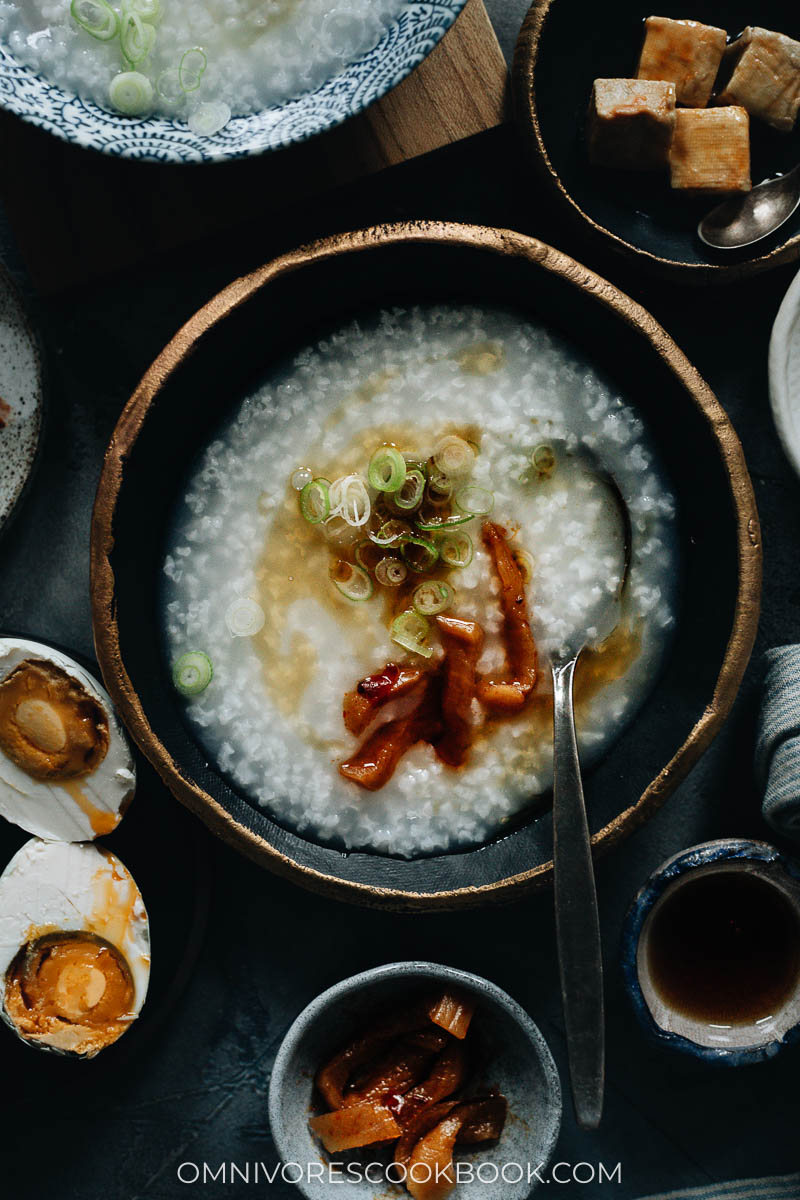
An introduction to plain congee
Growing up in Beijing, white plain congee appears on our dinner table just as often as steamed rice. It is usually served as a side dish that compliments the other mains, such as stir fried veggies and braised meat.
I consider the function of congee to be half soup and half starchy staple. Because a full Chinese meal usually contains three dishes and one soup (三菜一汤) with a starchy staple (rice, noodle, bread etc). The soup is especially important because we love to wash down the “dry” food with something runny. The congee is a convenient way to add a soup without too much effort or cost.
The plain congee itself is very simple and humble, usually only containing rice and water.
Unlike many Western-style congees I’ve seen after moving to the US, our daily congee does not use chicken or other types of broth, which is considered a luxury in China (most broths are homemade and not store-bought). And we usually add a few small dishes on the side, such as pickles or salted duck eggs, to add flavor to the congee.
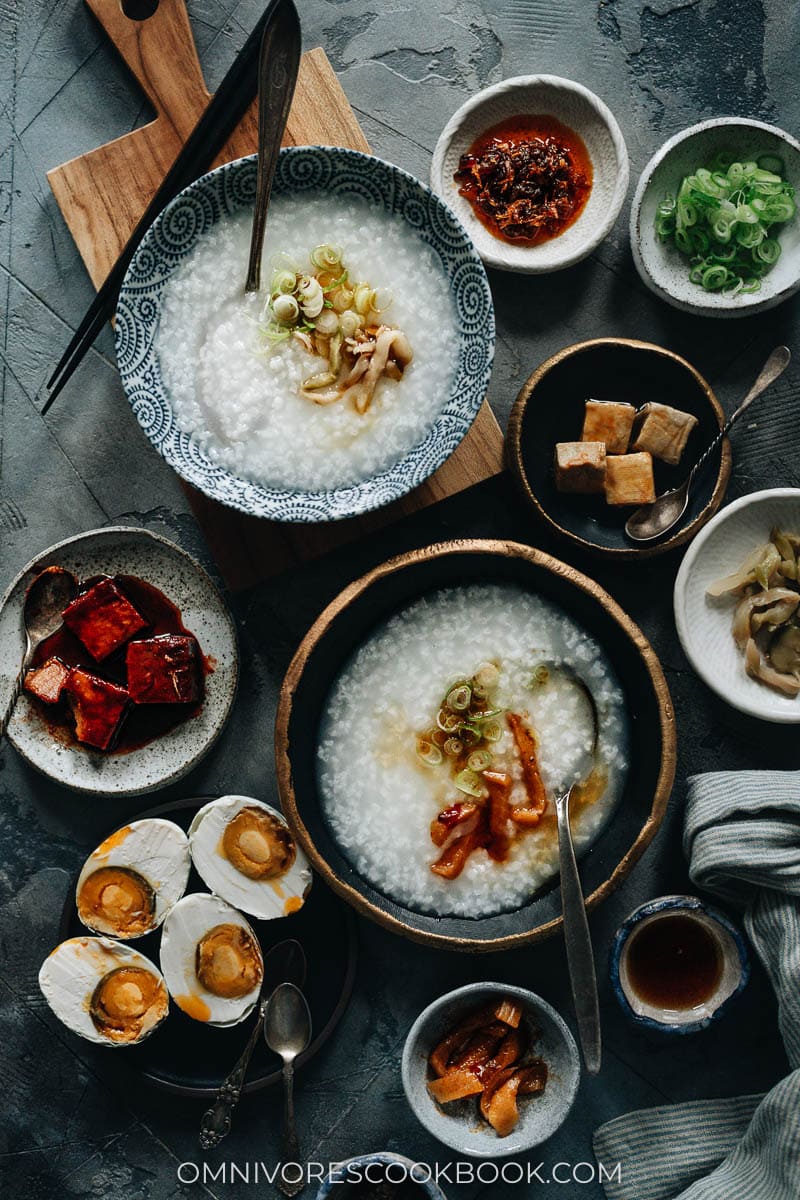
How to make plain congee
What type of rice to use
My favorite rice to use for congee is short grain rice. It creates a creamy and starchy texture that I love. You can use medium grain as well, which produces a very similar result.
I would avoid long grain rice (including jasmine rice). It yields a goopy and mushy result with more starch released into the water and the grain breaking down, but the texture is much thinner.
Two cooking methods
Making congee is super simple although it does take more time than making steamed rice. You can either use a regular pot to cook it on the stovetop or use an Instant Pot (or pressure cooker).
Personally, I prefer to cook my congee in the Instant Pot. It is hands-off and it generates a better result.
NOTE, it won’t really save time to use an Instant Pot. Although you only use a fraction of the cooking time (25 minutes instead of 1 hour), it takes a while to add and release the pressure. So you’ll end up using the same amount of time as you would on the stovetop.
The main appeal of using an Instant Pot (or any pressure cooker) is that it’s very hands-off and you don’t need to monitor it during the one-hour span. Unlike the stovetop method, where you need to keep an eye on it to prevent it from spilling and scorching the bottom.
Plus, pressure cooked congee will have a slightly starchier result, if that’s the texture you’re looking for.
Either way, you will need to rinse the rice prior cooking, then simmer the rice with water until it’s fully cooked.
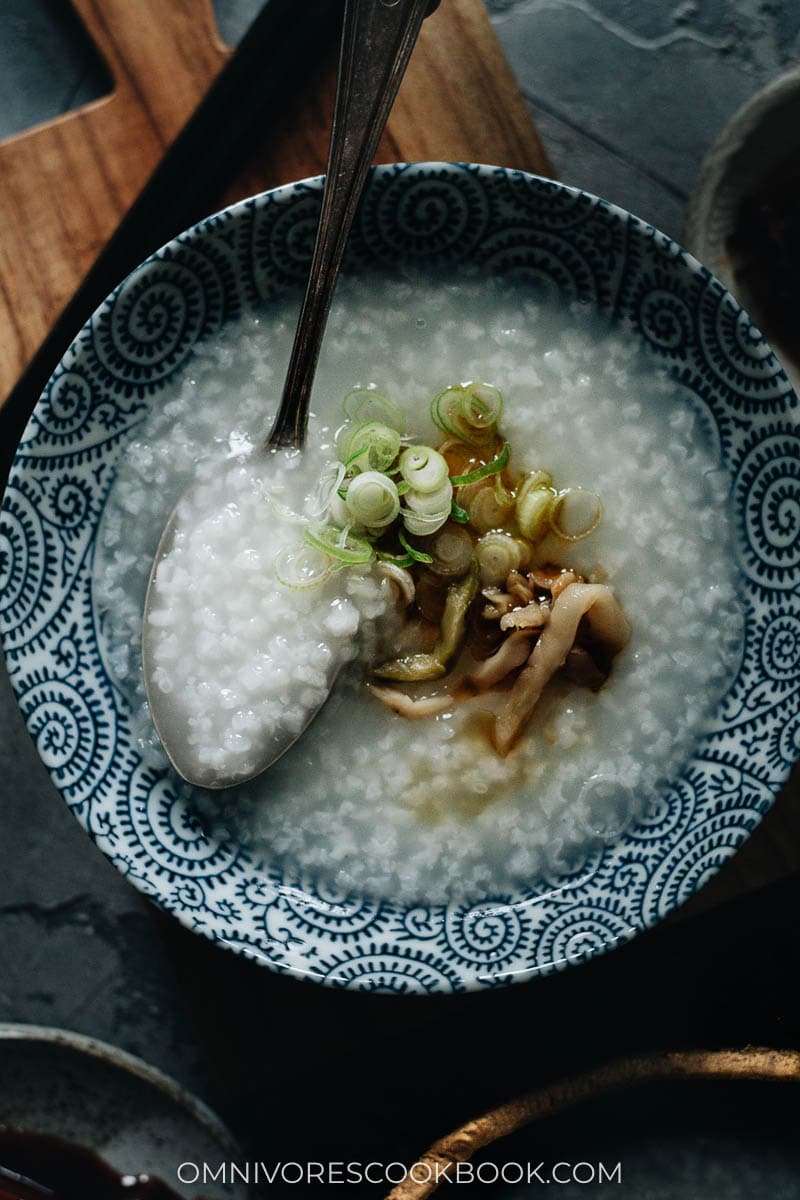
Water ratio
Everyone has their own preferred texture when it comes to congee.
Personally, I like mine thin and runny if I plan to serve it as a soup. Or medium-thick if I want it a bit more prominent with a few toppings.
On the other hand, you might like your congee very thick and cozy, like a bowl of creamy oatmeal.
In the recipe below, I listed three options – thick, medium-thick, and runny.
- Thick congee – For 1/2 cup rice you will need 4 cups of water in the Instant Pot, or 8 cups of water for the stovetop. It will yield a result like creamy oatmeal.
- Medium-thick congee – For 1/2 cup rice, you will need 5 cups of water in the Instant Pot and 10 cups of water for the stovetop. The texture is shown in the pictures in this blog post.
- Runny congee – For 1/2 cup rice, you will need 6 cups of water in the Instant Pot and 12 cups of water for the stovetop. A soupy texture that washes down other heavier dishes.
NOTE: pay attention at the end of the cooking if you’re using the stovetop method. The congee will thicken up quite a lot towards the end and you need to frequently stir it to prevent the bottom from scorching. Especially if you cook the thick type of congee, you should stir constantly at the end (just like when cooking oatmeal).
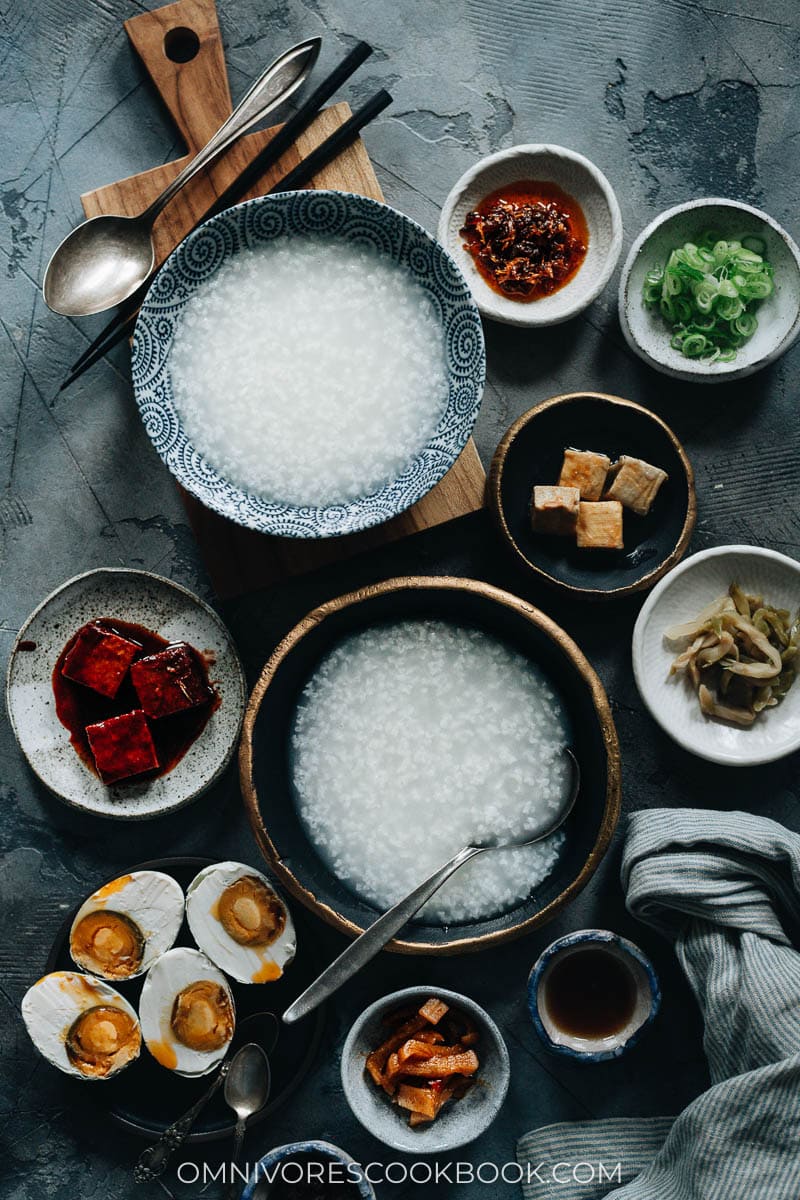
Topping options
I’ve shared a few topping options I like the most. They’re more for inspo than a specific prescription and you’re very welcome to top it with whatever ingredients you love the most.
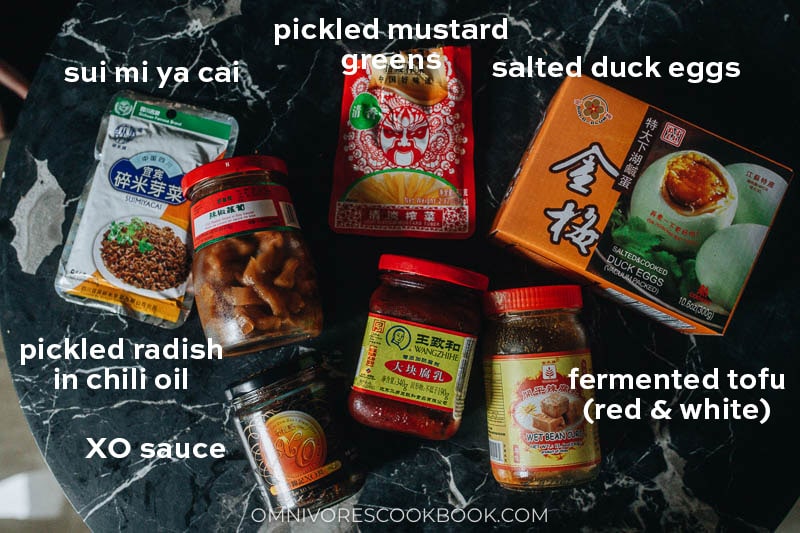
Because I’m originally from Beijing, my family’s favorite congee toppings include salty pickles, fermented tofu (quite funky and some people call it Chinese blue cheese), and salted duck eggs. All of them are very rich and salty, but would pair perfectly with plain congee.
NOTE: The pickles I serve with the congee are usually the salty type, such as pickled mustard tubes, pickled radish in chili oil, and Sui Mi Ya Cai.
You can also top the congee with XO sauce, which is more of a southern Chinese style.
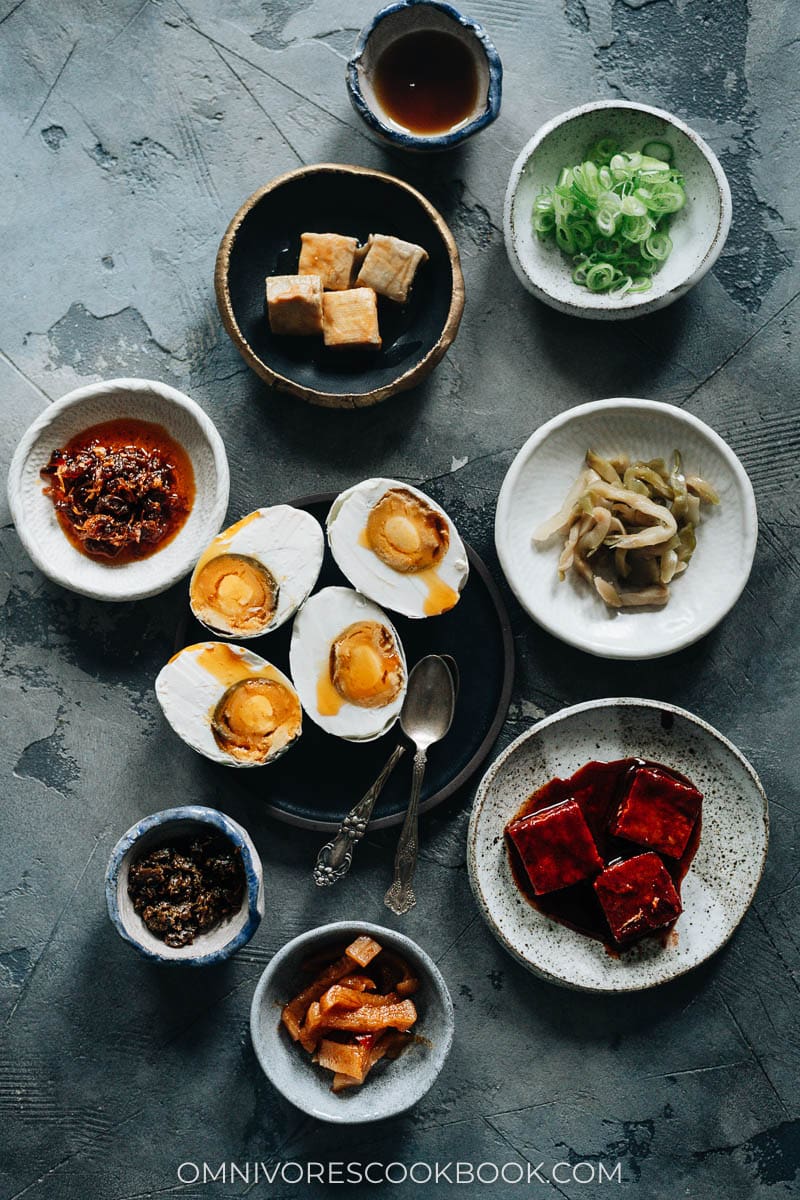
For a thicker congee, it’s also great to add soy sauce, chili oil (or sesame oil), and fried shallots (similar to how I make savory oatmeal).
Another option is to sweeten your congee. It was one of my favorites when I was a kid. You can use regular sugar, brown sugar, or any other type you prefer.
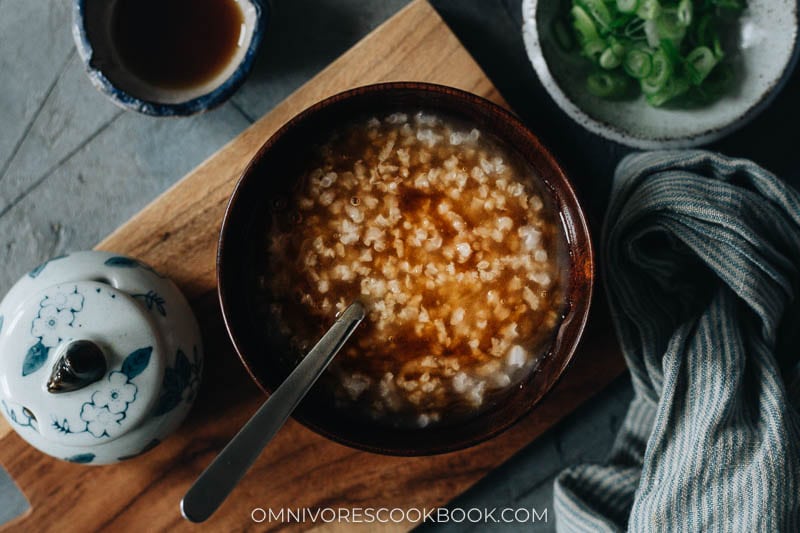
Afterthoughts
If you’re looking for a fancier congee, my seafood congee and the century egg congee and chicken might be great options.
If you prefer to make a fancier congee, it’s totally OK to replace the water with chicken broth. In this case, you might consider to salt your congee once it’s done, drizzle a bit of sesame oil and serve it with some chopped green onions. You can also throw in some cooked meat (leftover rotisserie chicken or roast pork) to add volume.
For me, the humble plain congee made with water and served with salted duck eggs gives me the ultimate comfort.
Want to learn more about Chinese Cooking? Sign up for my newsletter to receive the 5-Day Chinese Cooking Crash Course and recipe update!
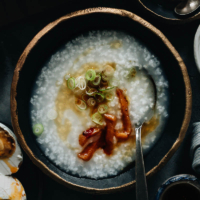
How to Make Congee (Plain Congee, 白粥)
Ingredients
- 1/2 cup short grain rice (or medium grain rice)
Instant Pot
- 5 cups water (or 4 cups for a thicker texture, or 6 cups for runny texture)
Stovetop
- 10 cups water (or 8 cups for a thicker texture, or 12 cups for runny texture)
Topping Options
- Pickled Chinese mustard tube (or other pickles you prefer)
- Salted Duck Eggs
- Fermented Tofu (Furu)
- XO Sauce
- Brown sugar (any type you prefer)
Instructions
- Add the rice to a large bowl and run it with tap water to cover the rice. Use your fingers to gently rinse the rice in a circular motion a few times, then drain off the water. Repeat 1 to 2 times.
Instant Pot Method
- Add the rice and water to your Instant Pot. Cover and seal the lid. Select high pressure, and set the timer to 25 minutes. Once done, let the pressure release naturally.
- Once the pressure has fully released, open the lid and stir the congee with a ladle. It might look thin once it’s done cooking, but it will thicken up a bit once you stir it well and let it sit for a few minutes. If you want to change the texture of the congee, turn on the “Saute” function and let it boil down for a few minutes and stir constantly, until it turns thicker. Or you can pour in a bit of hot water and stir it, to thin it out.
Stovetop Method
- Add the rinsed rice and water to a medium-sized or big, tall pot. Bring to a boil over high heat. Stir a few times to make sure the rice doesn’t stick to the bottom.
- Turn to medium-low or medium heat to reduce to a simmer. Cover the pot halfway to keep the water boiling without spilling over. Simmer for 45 to 50 minutes, depending on the texture you’re looking for. Stir the congee a few times during cooking. Towards the end of cooking, the congee will get quite thick and sticky. Stay near the pot and stir frequently over the last 10 to 15 minutes. It will easily spill if covered too much or if the heat is too high. The rice will stick to the bottom if you don’t stir enough.
Serve
- Serve the congee hot or warm with any topping options you prefer. You can also replace steamed rice with the congee as a side, to serve with other dishes.
Store and reheat
- You can store the congee in a sealed container in the fridge for 3 to 4 days. The congee will continue to thicken. To dilute it, you can add a splash of water to the congee and heat it either on the stovetop or in the microwave.
Nutrition
If you give this recipe a try, let us know! Leave a comment, rate it (once you’ve tried it), and take a picture and tag it @omnivorescookbook on Instagram! I’d love to see what you come up with.
Other homestyle comfort food
- Chinese Steamed Eggs (鸡蛋羹)
- Bean Sprout Stir Fry
- How to Make Steamed Dumplings from Scratch
- Chinese Napa Cabbage with Glass Noodles
- Wonton Soup
Lilja Walter is a part of the Omnivore’s Cookbook team and worked closely with Maggie to develop and test this recipe.













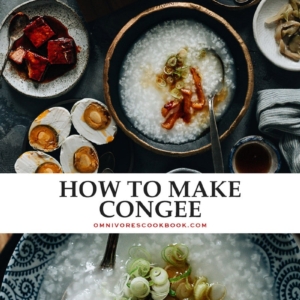
My rice cooker has a porridge option, it’s supposed to be able to make congee, although I’ve never tried it. Can I use the same water-rice ratio as for the instant pot method?
You definitely can use a rice cooker to cook congee if it comes with the setting. Does it have water mark inside of the pot (many rice cooker does). If yes, you should use the water ratio that comes with the rice cooker. If not, the water ratio should be closer to the Instant pot ratio.
Please clarify that for each of these recipes, Pre-cooked rice is the ingredient before making the Confee.
Many Thanks. Enjoy all of your newsletters
Hi Alan, I did not use pre-cooked rice. All the rice I used in each method is raw rice.
I was wondering if I could use Arborio rice to make congee?
I guess you can, but the consistency and texture will be off and you’ll likely to use a different water ratio.
Just did this, really hit the spot for me. Used 4 cups of water. Will consider broth next time.
Added thousand year eggs, furu and rousong.
Madam, what is the size of the cup as specified: rice cooker cups (180 ml) or some other size?
Thanks
I used the regular US cup which is 240 ml.
Thanks.
Maggie, this was the best congee recipe I’ve come across on the internet. Congee came out perfectly. I appreciated that you provided different liquid measurements according to how thick one desires the congee to be.
Hi! I am making plain congee for health reasons, no oil allowed. I’m considering an Instant Pot, but they recommend oiling the pot to avoid sticking. My main concerns are the messy frothing up and over on the stovetop and also in a slow cooker, and difficulty of cleanup, both from frothing up and sticking. Will the instantpot solve any of these issues? I’ve been cooking on stovetop for 4 hours. If I find it stuck, I add water with heat off and it unsticks. Hoping to cut down that time and the mess. I’ve never had a rice cooker; would that work better? Thank you
For congee, an Instant Pot works so much better because you do not need to add any oil, and it doesn’t stick (unless you make super thick congee). Stovetop congee is tricker because it takes a long time to cook, and you do need to watch the pot and stir frequently to prevent from sticking. but Instant Pot doesn’t have these issues. You can use a rice cooker as well. Since rice cooker usually comes with a nonstick interior, it won’t stick either. However, I think Instant Pot makes better congee (the high pressure releases more starch from the grain, so the congee is nice and sticky).
You can check out my chicken congee recipe made in Instant Pot: https://omnivorescookbook.com/chicken-congee/ I added sesame oil at the end for the flavor but there’s no oil during the cooking process.